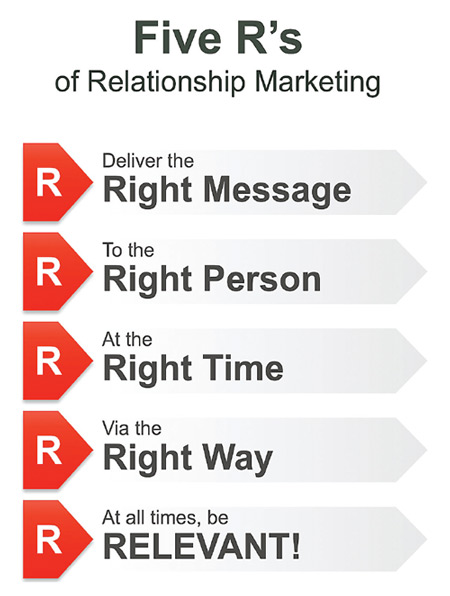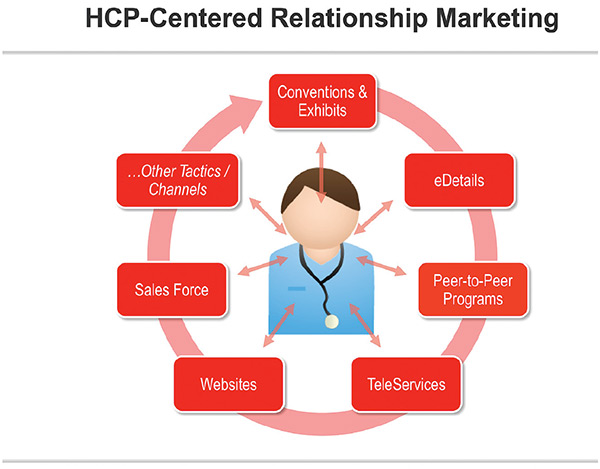Over the past few years, the practice of Relationship Marketing (RM) within pharma has been growing at an extraordinary rate. Some experts estimate that U.S. drug firms spend $300 to $650 million annually on RM software and systems, and those are estimates from 2009.1 Almost any brand that markets toward consumers directly has some sort of CRM program to build a direct relationship with patients. In regard to healthcare practitioners, brands are expanding the direct-to-provider realm as well. With essentially every new product launch website over the past year, you find an email sign-up for more info from the company, for both patients and HCPs. But are brands really understanding and taking advantage of all aspects that true relationship marketing can provide? Without providing a definitive or potentially damning answer, this article strives to provide a handful of considerations for brands to think about as they evaluate their RM strategy and ecosystem.
Many RM models start with a simple mantra: “Put the customer at the center of everything you do.” The broader practice of pharma marketing should start with the same mantra—at least that’s what most Marketing 101 professors would likely propose. Put the customer at the center and then strive to implement five simple R’s: provide the Right message, to the Right person, at the Right time, in the Right way. And ultimately, just be Relevant. Follow the R’s and customers will reward you for the efforts made on their behalf.
So, what is relationship marketing really? Fully realized, it is simply an overarching strategy for managing and optimizing all marketing interactions with customers. In practical terms, it is the convergence of data and technology to enable targeting and measuring of marketing activities at the individual customer level.
Many systems and infrastructures built to execute a relationship marketing strategy toward HCPs put the clinician at the center of an array of channels/tactics/messages, which all surround that customer. These models are sometimes called Clinician Relationship Management,2 Multi-channel or more recently Multi-channel 2.0 (MC2),3 Hub-and-Spoke, Integrated Marketing,4 or simply some flavor of 360-degree marketing. No matter what the name, all these models have common aspects and attributes that may be easy to overlook, but it is important to deeply consider how they function. Let’s explore the HCP-centered RM model in more detail.
Most models surround the customer with a variety of touch points indicating a “surround-sound” coordination of messages and tactics that are aimed at the customer.
In the model displayed below, however, notice the arrows connecting all the spokes to the hub. They are two-way for a reason. They imply the flow of ideas, insights and, ultimately, data go both to and from the hub to enable communication and learning. Also notice the circular arrow behind all the spokes. In conjunction with the two-way arrows, all tactics/channels are interconnected and the whole ecosystem should be “all-knowing” and flexible. To manage and make the integration of all marketing efforts a reality, these two-way arrows show the importance of inward and outward flows of information—i.e., data.
Marketers should take advantage of these flows to optimize and integrate their entire marketing portfolio. It may be more difficult to do so, but it is necessary to fully realize the potential of any RM initiative.
Considerations for Inward Flows—The ‘INs’
In most RM initiatives, every tactic/channel will be feeding data and insights into the hub at some level, but that is rarely good enough. The depth of the data should be maximized and focused on providing actionable insights. Consider each tactic/channel and ask yourself: Is it only giving a surface-level insight such as an email send or an attendance record? Or, could each tactic be tracking deeper metrics, such as time spent on pages, topics discussed or reviewed, sentiment or other data that could drive a change in future tactics? What else can be learned or confirmed about the customer by that tactic, channel, interaction or transaction?
That’s where the real insightful data can originate. In some HCP-centered RM ecosystems, there is a requisite to institute a steady and consistently deep level of information provided by all channels and tactics. It is important to ensure that all the suppliers and partners that are part of this ecosystem not only provide this depth of information—particularly physician-level data—but also provide it in a consistent and efficient fashion. This consistency is difficult to implement, but is important to ensure success. Without this consistency across channels, it becomes exceedingly difficult to compare and contrast your tactics.
However, once you have maximized the inward flow of data, you must then take it a step further and maximize the opportunity for efficiency. Every channel should provide a mechanism for a new customer to opt-in and allow you to market to them more efficiently in the future.
For example, if a doctor is visiting your convention exhibit booth, can they sign up for an upcoming teleconference, request follow-up from a rep or get materials delivered after the event? Getting someone engaged can take a lot of effort, so be sure to make the most of that interaction and promote other offerings. Knowing that it may otherwise be a while before there is another opportunity to deepen a relationship, make one happen. Marketers across most industries agree that keeping an existing customer is easier than acquiring a new one. Leverage your relationship marketing ecosystem to maximize that opportunity.
Considerations for Outward Flows—The ‘OUTs’
When thinking about the outward arrows and flows, it is critical to ensure that each channel and tactic is truly dynamic and flexible based on all the deep insights you’ve been able to gather from the others.
Digital channels and tactics can very easily be programmed to alter key messages presented based on previous transactions, history, insights and other data gathered from other channels within the RM ecosystem. Getting a multitude of messages through medical/regulatory/legal approval can be daunting, so this “custom” messaging may simply be a reordering or a triaging of the most important messages to deliver at the right moment based on the insights about the customer. Technology shouldn’t create more work for marketers; it should ultimately just make your work work smarter.
For instance, your digital channels (particularly email) should trigger based on customer engagement with any/all of the other channels. Or, when supporting the reengagement of a previous customer, have your RM system say “thank you” for completing any given tactic and recommend an appropriate next step to take. This is one of the easiest ways to not only be relevant, but also truly build upon the relationship aspect of your RM effort.
The sales force channel in particular is another channel that can very easily bend, flex and customize itself based on information. With less and less time in front of customers per interaction, getting the relevant messages out as quickly as possible is paramount. Representatives of the future need to be information “concierges” for their customers, adept at providing the right information at the right time.
Messages should be small enough and nimble enough to allow reps to easily identify and apply the right ones for the HCP at that moment. The messages also ensure that reps are knowledgeable about all the other channels that they can use to appropriately guide physicians toward the right future tactics and engagements after the rep leaves the office.
Finally, reps should be provided with a window into everything that occurs outside of their own interactions. This knowledge—in the hands of a smart and agile rep—can be immensely powerful, even access-building. Smart reps know that it takes a team effort to win the hearts and minds of HCPs. These reps know that changing behavior doesn’t come from a handful of face-to-face interactions, but from a coordinated, relevant multi-channel campaign they can help drive.
Putting It All Together
If you’ve been able to create an overarching model and framework for all of your interactions with customers, the challenge now may be to determine how everything works together—and ultimately how it enables better marketing. Particularly as pharma companies move from blockbuster-driven marketing to a blended portfolio-based reality, balancing everything takes on newfound importance. Good RM is not just a theory; it is beginning to be applied at many leading companies. Smart firms are finding the right combination of theory and application that makes this work in their world, with their people, channels and tactics.
Well-constructed relationship marketing systems have the ability to predict what channels, tactics and messages will resonate most with customers and which will ultimately change behavior. A bonus: Without too much added effort, a company can layer in cost to truly measure and predict what tactics are worth pursuing, and to whom. The challenge now: Who is willing to let their entire marketing muscle flex based on these predictions? I propose those who truly leverage the ins and outs of relationship marketing will have a competitive advantage for years to come.
References
1. Frost & Sullivan’s Sujith; IDC, 2009 – http://www.pharmathought.com/?p=203
2. https://www.pm360online.com/putting-the-r-in-clinician-relationship-management
3. https://www.pm360online.com/peeling-back-the-onion
4. https://www.pm360online.com/integrated-marketing-the-future-of-pharma





